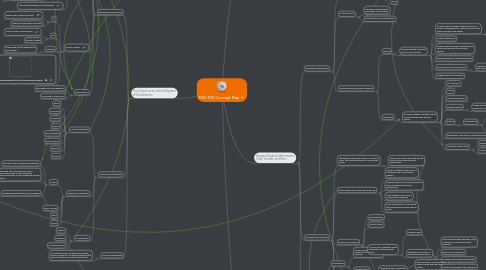
1. The School as an Informal System of Socialization
1.1. Philosophical Perspectives
1.1.1. Mead's Theories
1.1.1.1. The "I" and the "Me"
1.1.1.2. Ego-centrism/Individualism vs Internalized Societal Expectations/Attitudes/Values
1.1.2. Schütz's Theories
1.1.2.1. Direct or Indirect Copying of Social Attitudes
1.1.2.1.1. Recognition of Consequences
1.1.2.1.2. "Common Sense" Knowledge
1.1.2.1.3. Knowledge Through Experience
1.1.3. Piaget's Theories
1.1.3.1. Moral Autonomy
1.1.3.1.1. Understanding reasons behind misbehaviour
1.1.3.1.2. Recognizing why something is misbehaviour
1.1.3.2. Moral Realism
1.1.3.2.1. Judging misbehaviour in terms of the severity of punishment
1.1.3.3. Learning from Rewards and Punishments
1.1.4. Freud's Theories
1.1.4.1. Id
1.1.4.1.1. Based on the "Pleasure Principle"
1.1.4.1.2. Inherent, human wants and needs.
1.1.4.2. Ego
1.1.4.2.1. Tries to satisfy Id within reason
1.1.4.2.2. Decision-Making
1.1.4.3. Superego
1.1.4.3.1. Overarching societal expectations and attitudes.
1.1.4.4. http://freudsigmund.blogspot.ca/2010/12/id-ego-super-ego.html
1.1.5. Internalization
1.1.5.1. Evaluating One's Own Behaviour
1.1.5.2. Discerning a "Status Quo"
1.2. Sociological Perspectives
1.2.1. Primary Socialization
1.2.1.1. Family
1.2.1.2. From Birth
1.2.1.3. Language
1.2.1.4. Identity
1.2.1.5. Moral Standards
1.2.1.6. Gender Identity
1.2.1.7. Ethnicity
1.2.1.8. Religion
1.2.2. Secondary Socialization
1.2.2.1. School
1.2.2.1.1. The main route of secondary socialization.
1.2.2.1.2. Teachers have their own expectations and standards, which adds to the socialization individuals and groups of like-minded/like-abilitied individuals.
1.2.2.1.3. Grouping students together via streaming.
1.2.2.2. Other Families
1.2.2.3. Peers
1.2.2.4. Media
1.2.3. "Social Reality"
1.2.3.1. External
1.2.3.2. Objective
1.2.3.3. Culturally Specific
1.3. Historical Perspectives
1.3.1. Socialization was a concept used to explain, predict, and get rid of a child's behaviours that were not wanted in society (misbehaviour).
2. Public Education, Globalization, and Democracy: Whither Alberta?
2.1. Sociological Perspectives
2.1.1. Globalization
2.1.1.1. Complex interactions between different cultures, religions, and identities.
2.1.1.2. Internationalism
2.1.1.2.1. Hindered by the competitive, international marketplace.
2.1.2. Education as a Resource
2.1.2.1. The theory is that the best educated pool of people will lead a nation to success.
2.1.3. Criticisms of Education
2.1.3.1. Social democrats think that schools socialize students into fields of work by telling them that`s all they can achieve, thereby limiting their options.
2.1.3.2. Failure to address racism and sexism.
2.1.3.3. Conservatives felt that education undermined traditional moral beliefs and family attitudes.
2.1.3.3.1. "Why are schools brainwashing our children" - Cynthia Reynolds, 2012
2.2. Historical Perspectives
2.2.1. Public education was created in a specific economic context
2.2.1.1. In order to change infrastructure, you have to rebuild ideologies from the ground up since it is in a new educational context.
2.2.1.2. Fundamental changes tend to happen with changes in government.
2.2.1.2.1. More Privatization
2.2.1.3. Governments have control over political, moral, cultural, and economical standings of schools through legislation and policy.
2.2.1.4. Less capital means less academic funding which means poorer education practices.
2.3. Philosophical Perspectives
2.3.1. Policies of Inclusion
2.3.1.1. All abilities, religions, genders, and ethnicities.
2.3.1.1.1. As per the Education Act, we as teachers must treat every student as equal.
2.3.1.2. Streaming: All students can learn the material at their own levels.
2.3.1.2.1. Universal Design for Learning
2.3.1.2.2. Engaged Inquiry
2.3.2. Liberalism
2.3.2.1. Focus on individual achievement rather than societal values.
2.3.2.2. Amorality
3. Unequal Student Attainments: Class, Gender, and Race
3.1. Philosophical Perspectives
3.1.1. Schools "reproduce" inequalities in that they do not address pressing issues in the classroom and allow them to fester.
3.1.1.1. Gender
3.1.1.2. Ethnic
3.1.1.3. Class
3.1.2. "Vertical Mosaic"
3.1.2.1. The school being the main homestead for inequalities.
3.1.2.2. Inequalities of class and ethnicity.
3.1.3. Mechanisms of Educational Inequality
3.1.3.1. Primary
3.1.3.1.1. Directly impedes a student's ability to learn content.
3.1.3.2. Secondary
3.1.3.2.1. Indirectly impedes a student's ability to learn through other external factors.
3.2. Sociological Perspectives
3.2.1. The higher the economic status of a student's family, the more likely they are to succeed at school.
3.2.1.1. Parents can supply their students with more resources and academic opportunities.
3.2.2. Large changes from what they used to be.
3.2.2.1. Women now have a lower drop-out rate/higher rate of professional degrees.
3.2.2.2. However, there are still job fields that are very male-dominant (such as engineering).
3.2.2.3. Huge changes can be seen in commerce and medicine.
3.2.2.4. Some "reverse flow" of men going into predominantly female fields of study.
3.2.3. Diverse, but not equal.
3.2.3.1. Multiculturalism
3.2.3.2. Cultural Mosaic
3.2.3.3. "Us and Them" mentality; visible minorities and the dominant group.
3.2.3.3.1. "Abella Image"
3.2.3.3.2. Disparities in education in minorities possibly due to...
3.2.4. Disparities between schools themselves.
3.2.4.1. Funding
3.2.4.2. Opportunities
3.2.4.3. Athletics
3.2.4.4. Arts
3.2.5. Unequal family value to education is a large contributing factor to whether a student succeeds or fails.
3.2.5.1. Also depends on socioeconomic status.
3.2.5.2. "Summer Setback" for students who do not participate in educational activities year-round.
3.3. Historical Perspectives
3.3.1. Some inequalities stem from recruiting in the workforce in the 1960s from countries with very little formal education.
3.3.1.1. Attributed to the immigration policy rather than a failure of the school system.
4. Nourishing the Learning Spirit: Coming to Know and Validating Knowledge: Foundational Insights on Indian Control of Indian Education in Canada
4.1. Sociological Perspectives
4.1.1. Indigenous Knowledge is whole-learning.
4.1.1.1. Standardized testing stops being meaningful.
4.1.1.2. Humanistic Knowledge
4.1.1.3. Body, Mind, Spirit
4.2. Philosophical Perspectives
4.2.1. Indian control of Indian education means that FNMI students may be able to get the cultural and social values they need to learn through where most of their socialization occurs: school.
4.2.2. "Nourishing the Learning Spirit"
4.2.2.1. Inter-connectedness of Indigenous Knowledge
4.2.2.1.1. http://youtu.be/ycQtQZ9y3lc?t=7m26s
4.2.2.1.2. First Nations Holistic Lifelong Learning Model - Anuik, 2013 (Presentation)
4.2.3. Epistemology: How do we know what we know?
4.3. Historical Perspectives
4.3.1. Colonial Mentality of "Kill the Indian, Save the Man"
4.3.1.1. Burial of FNMI...
4.3.1.1.1. Language
4.3.1.1.2. Culture
4.3.1.1.3. Dress
4.3.1.1.4. Educational Systems
4.3.1.1.5. Traditions
4.3.1.1.6. Ways of Life
4.3.1.1.7. Family Values
4.3.2. Education by nuns in day schools.
4.3.3. Residential Schools
4.3.4. Assimilation into now predominantly white society.
4.3.5. Re-affirming policy with Indigenous peoples means strengthening a relationship between Indigenous peoples and the government.
